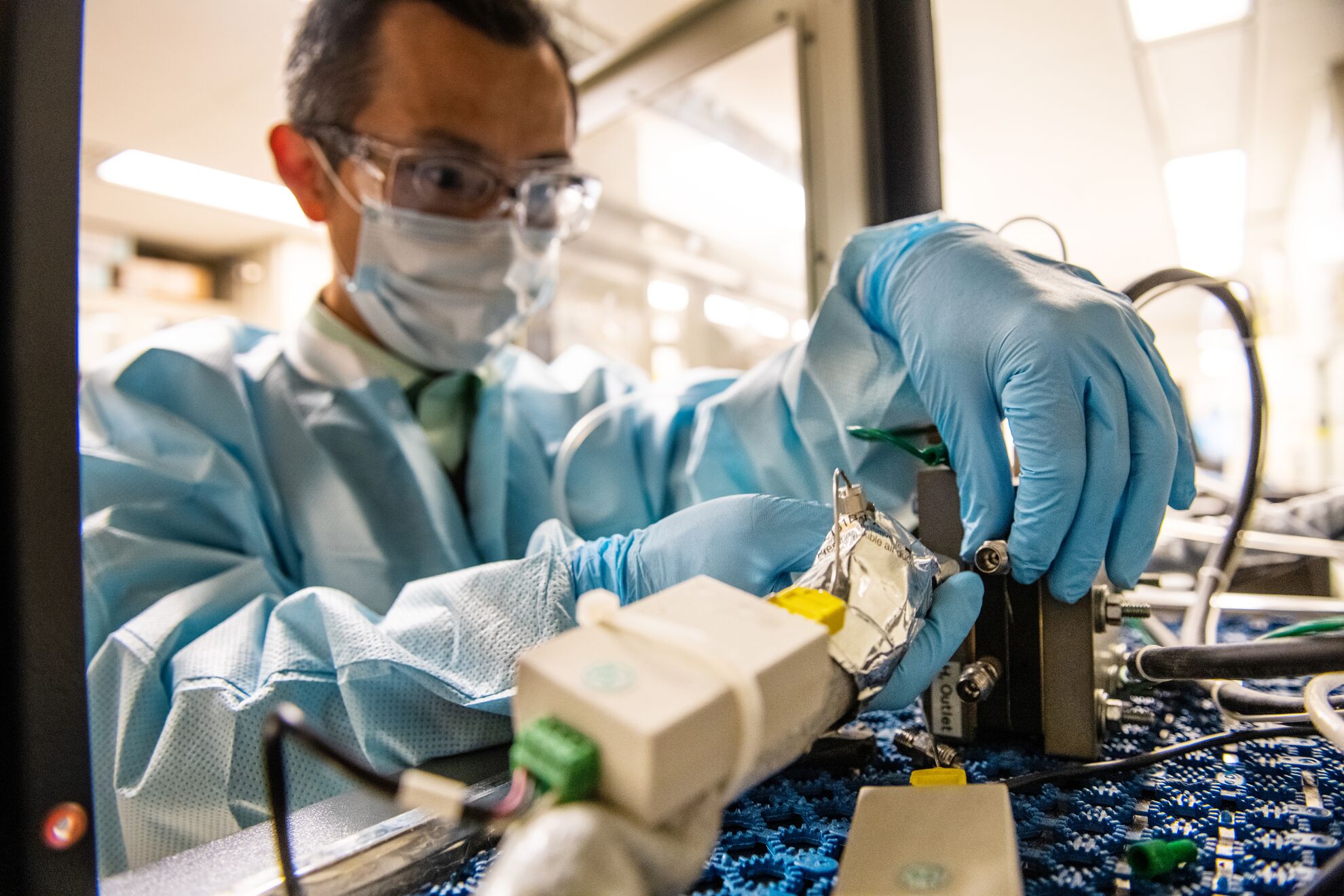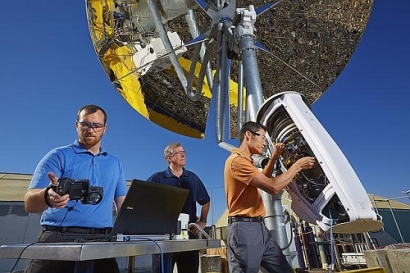
Chemical Energy
Storage
Chemical Energy
Storage
Putting and pulling electrical power
in and out of chemical bonds
Putting and pulling electrical power
in and out of chemical bonds
Fossil fuels are one of the most familiar examples of storing energy in chemical bonds. Energy is released when the bonds in chemical compounds, like petroleum, coal, and natural gas, are broken. But energy is also stored in other chemical forms, including biomass like wood, gases such as hydrogen and methane, and batteries. These other chemical forms support our electric grid, industrial operations, and the transportation sector.
Chemical storage to gird the grid and run the road
Hydrogen and other energy-carrying chemicals can be produced from diverse, domestic energy sources, such nuclear power and fossil fuels. Converting energy from those sources into chemical forms creates a high energy density fuel. Hydrogen can be stored as a compressed gas, liquid hydrogen, or inside materials. Depending on how it is stored, it can be kept over long periods and is not seasonally dependent like pumped hydro.
Chemical storage can add power into the grid and also store excess power from the grid for later use. The flexibility of being able to return stored energy to the grid or sell the chemical for industrial or transportation applications provides additional opportunities for revenue not possible for storage devices like batteries.
Leading the way in chemical energy storage

PNNL has long held a position of leadership in chemical energy storage. PNNL’s expertise in chemical storage research and development supports the U.S. Department of Energy’s Hydrogen and Fuel Cell Technologies Office, the Bioenergy Technologies Office, and the Office of Fossil Energy. Our capabilities have contributed to the development of hydrogen production technologies, catalysis for hydrogen production and fuel cells, storage infrastructure, and materials development and characterization, including component postmortem analysis and safety.
For hydrogen storage, PNNL is involved in accelerated materials discovery and development, including ceramics, polymers and polymer composites, and catalysts needed to create production systems and storage devices for the chemicals that will store energy in their bonds. Distinctive facilities at PNNL are designed to synthesize these materials and scale-up systems for testing. Additionally, PNNL is at the cutting edge of chemical energy storage in molecules other than hydrogen such as formic acid, ammonia, methanol, ethanol, and other organics.
Advanced characterization capabilities tell researchers how the materials will hold up under severe operating conditions. PNNL conducts performance assessment and validation of the systems under simulated service conditions down to the component level.
Chemical energy storage scientists are working closely with PNNL’s electric grid researchers, analysts, and battery researchers. For example, we have developed a hydrogen fuel cell valuation tool that provides techno-economic analysis to inform industry and grid operators on how hydrogen generation and storage can benefit their local grid. It goes beyond simply determining the levelized cost of electricity by including the values of grid services beyond energy storage. This analysis includes the potential to sell hydrogen on the commercial market. It can also be used to size the electrolyzer, which uses electricity to split water to make hydrogen and oxygen, and fuel cells for highest potential revenue.
Hydrogen generation
For hydrogen generation, PNNL leads development of solid oxide electrolyzer cells that efficiently break down the bonds in water to produce oxygen and hydrogen gas. Our expertise includes:
- new materials for cells, seals, barrier layers, and interconnects
- machine learning for identifying new materials
- novel, low-cost, high-volume cell and stack fabrication
- modeling for cells, stacks, and systems
- stack performance and parametric testing
- water electrolysis and co-electrolysis of steam and carbon dioxide
- cell/stack postmortem characterization.

Other hydrogen production methods we’ve developed include systems to convert landfill gas and other waste gases to hydrogen and solid carbon, and the Solar Thermochemical Advanced Reactor System, which concentrates solar energy to provide heat for many different hydrogen production technologies.
Storage
There are two fundamental ways to store hydrogen—it can be stored in physical containers as a compressed gas or a liquid, or it can be kept using materials-based storage, in which hydrogen is stored in a chemical compound.
For physical storage, PNNL examines carbon fiber tank components and design and manufacturing processes. We’ve developed the “tankinator” tool to project the costs of this type of physical storage.
Power generation using fuel cells
Hydrogen is converted to electricity using fuel cells that, broadly speaking, operate at either high temperatures or low temperatures. PNNL is a leader in developing high-temperature solid oxide fuel cells. For low-temperature proton-exchange membrane fuel cell technologies, we are addressing critical cost barriers. For example, through PNNL’s Institute for Integrated Catalysis, we are demonstrating a new catalyst that contains ultra-low amounts of expensive platinum.
We’re addressing another key cost barrier for hydrogen energy storage with our reversible solid oxide fuel cell, which utilizes equipment much more efficiently. In a traditional fuel cell system, the electrolyzer and fuel cell are different components. This means that when hydrogen is being produced by the electrolyzer, the expensive fuel cell is sitting idle. Likewise, when power is being generated by the fuel cell, the expensive electrolyzer is sitting idle. PNNL is overcoming this challenge with its reversible solid oxide fuel cell. A reversible fuel cell reacts hydrogen and oxygen in the air to make water and electricity or can operate in reverse to use electricity to split water into hydrogen and oxygen. The same stack is both a fuel cell and an electrolyzer, thereby eliminating equipment sitting idle.
Hydrogen infrastructure solutions
One of the key challenges for hydrogen infrastructure is the transportation cost. The least expensive way to transport hydrogen is through a pipeline. To access the millions of miles of natural gas pipelines already in place, PNNL is part of a large team evaluating the impact of blending hydrogen with natural gas. In addition, we are leading a team studying the impact of storing hydrogen gas in underground geologic structures.
When pipelines can’t be used, liquid hydrogen is a preferred state to move hydrogen. A liquid hydrogen tanker can replace four to sixteen compressed gas tankers, depending on which compressed gas tanker is used. However, current technologies to convert hydrogen gas to its liquid state typically involve lowering the temperature to minus 423 degrees Fahrenheit, which takes a lot of energy.
PNNL is developing a novel approach using materials with a magnetocaloric property to cool and liquefy hydrogen gas. When a magnetocaloric material is removed from a strong magnetic field, it cools rapidly. PNNL researchers are exploiting this effect to make a new cryogenic cooling system that is twice as efficient as current technologies and has similar or even lower capital costs. PNNL research could reduce the energy, and therefore the cost, required for liquefaction by 50%.
PNNL is part of DOE's Hydrogen Materials Compatibility Consortium (H-MAT), which studies hydrogen interaction with materials. Industry needs to know how materials change and perform under the effects of hydrogen and the impact of temperature and pressure swings that occur during storage and use. PNNL leads studies and testing of polymers that are used for liners, hoses, and sealing valves.
Hydrogen safety
Safety is crucial for the use of hydrogen in energy storage systems. PNNL runs the H2Tools portal for the DOE Hydrogen and Fuel Cell Technologies Office. This portal provides information for first responders to learn more about the difference between handling gasoline emergencies versus potential hydrogen incidents. H2Tools is a one-stop-shop for hydrogen safety, lessons learned, hydrogen properties, and useful calculators.
To increase the availability of our hydrogen safety panel, first responder training, and hydrogen safety expertise, PNNL recently teamed with the American Institute of Chemical Engineers to establish the Center for Hydrogen Safety. The Center for Hydrogen Safety is a global nonprofit dedicated to promoting hydrogen safety and best practices worldwide. Through this center, we promote the safe handling and use of hydrogen across applications.

